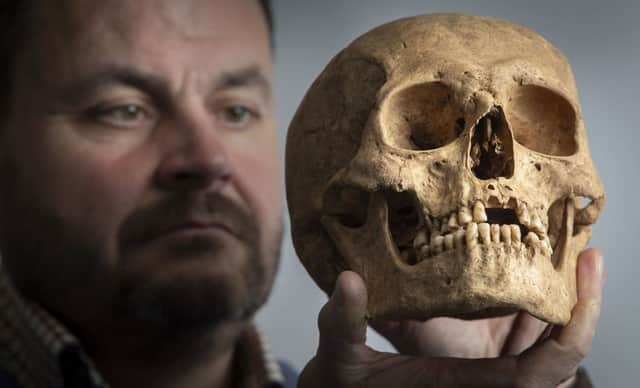Tragic graves give up their secrets


Excavations at an Anglo-Saxon cemetery in the Lincolnshire Wolds, previously unknown, have thrown up evidence of more than 20 lavish burials of women still wearing their jewellery. One was cradling a baby.
A series of finds by an amateur metal detectorist led directly to the large-scale examination by a team from Sheffield University – the first in the area since the 19th century.
Advertisement
Hide AdAdvertisement
Hide AdThey discovered a wealth of artefacts from the late fifth and mid sixth centuries, stunningly intact and including ivory from the tusks of African elephants.
Dr Hugh Willmott, senior lecturer in European historical archaeology at the university, said: “Almost without exception, the burials were accompanied by a rich array of objects.
“In the case of the woman with the baby, what you’re looking at is a snapshot of a personal tragedy. You’ve got a young lady, probably only late teens, cradling a new-born child which is presumably her own.
“The baby is resting on her forearm as if she’s holding it, and it appears that special care has been taken. There were also bunches of necklaces that had been placed on top of the baby, very deliberately.”
Advertisement
Hide AdAdvertisement
Hide AdDr Willmott said the cemetery appeared more typical of those previously found in Kent, which were associated with Germanic Jute communities, and raised possibility that the Anglo-Saxons had travelled further than had been thought.
The presence of African elephant ivory inside the graves, which has been carbon dated to the same period, had exploded previous theories that the communities had access only to the ivory of mammoths, preserved in the Siberian permafrost.
The first artefacts, including copper gilded brooches and spear heads, were unearthed from the site Scremby in summer last year, and led to a wider excavation a few months ago, with which international volunteers and RAF personnel from nearby stations, assisted.
Dr Willmott said: “What has been surprising is the collective whole of the site – 24 bodies and almost all of them female and very richly dressed.
Advertisement
Hide AdAdvertisement
Hide Ad“These women wore necklaces made from sometimes hundreds of amber, glass and rock crystal beads, used personal items such as tweezers, carried fabric bags held open by elephant ivory rings, and wore exquisitely decorated brooches to fasten their clothing.”
But he said that other than the baby in her mother’s arms, children were almost completely absent from the part of the cemetery to have been explored.
His colleague, Dr Katie Hemer, said the objects unearthed would now be subjected to further forensic analysis which would “ask and answer significant questions about early Anglo-Saxon communities in eastern England”.
She added: “We will analyse the elemental composition of the metalwork and identify the elephant species which produced the ivory rings.”